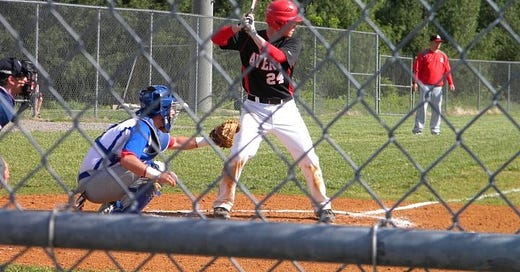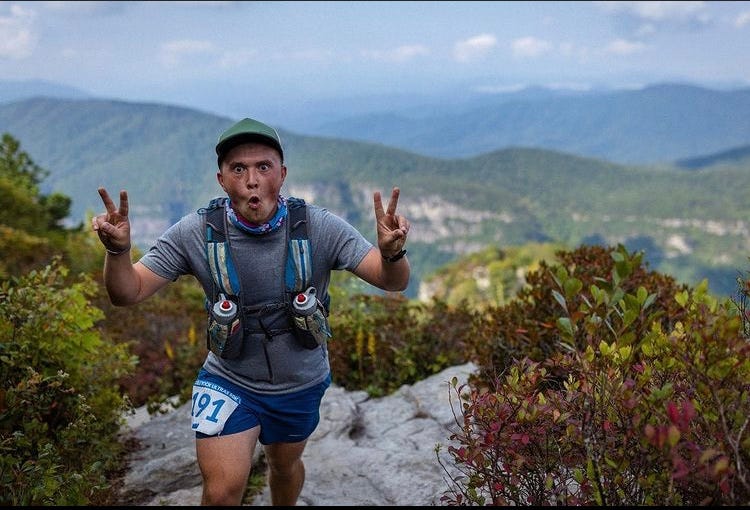It’s taken me a while to figure out what my calling is in life. Actually, I still don’t know what my calling is. In high school, like millions of other boys that thought a buzz cut with a #4 guard was the pinnacle of style, I was convinced my calling was baseball.
Breaking news, it wasn’t. But, as someone that grew up in a crucible of Carhartt and John Mellencamp, I stuck with my commitment despite figuring out by my junior year that I really liked bikes and catching trout a whole lot more than playing baseball during second winter (Spring) in North Carolina.
I had a few good seasons, but I wasn’t an all-star. Out of the scope of skills necessary to be a successful baseball player, I only excelled at one thing: hitting a curveball. My swing wasn’t powerful enough to match up to some of the fastballs I frequently saw and those hits usually died in the infield instead of going over the fence. But, if you threw me a hanging curveball over the plate, whether it was the first pitch or the seventh pitch, it was getting driven like a Cold-War test missile to right field.
Hitting a curveball isn’t that complicated. The key to success lies in letting the ball get closer to you before you start driving your bat towards it. This sounds easy, but for many baseball players, the mental and physical hesitation required to match a curveball is not nearly as natural as the light-speed reaction time that is needed to have a dying chance at connecting with an 80 mph high school fastball. If you couple that with the fact that the best pitchers know exactly how to throw off your timing by mixing up fastballs and curveballs sporadically, you can understand why many kids gravitate towards other sports.
After nine years of playing baseball, you’d think I’d be able to translate my strongest skill into something tangible in the real world. Alas, in this fast-paced American life that I find myself living in, I too still struggle to anticipate the unforeseen curveballs that I know are headed my way.
For the past four months, I’ve been training to race the Table Rock Ultras 50K, which finally happened this past Saturday. After building my running volume more strategically than ever before, I concluded my “real training” with my good friend and coworker Robbie two weeks ago in a 3 hour and 20 minute, twenty-mile long run through the mountains that felt like butter.
I spent the summer running, riding, and filtering ice-cold stream water on a weekly basis. Controlling my heart rate over long periods of time finally felt easy, and my fueling strategy was dialed. Many runs and rides ended with watery eyes of gratitude over just how in control I finally felt. In essence, I was uncharacteristically knocking fastball after fastball out of the park.
As any quality pitcher would, life saw me clinging to a pattern and threw me a curveball. This past Thursday, 48 hours before the race, I simply picked up a lost football at recess with my students. Upon returning to the upright position, my lower back locked up tighter than the Pentagon in the mid 2000’s. By that afternoon, I was in tears trying to navigate going up and down stairs. I slept on a heating pad that night and spent Friday morning at the chiropractor. I went into work Friday at noon.
What do you do when life grips the seam, flicks the wrist, and catches you off guard?
You keep your head in the game.
For about 12 hours Thursday evening, I was fit to be tied. I was bummed, I was hateful, and my dreams of shaving time off of my previous 50K time were crushed. Convinced that I would not be racing Saturday, my wife Bailey told me, “you’re not a teacup Yorkie, Jake, you have that DAWG inside of you. You are gonna be pissed if you don’t at least try.”
With some blunt but perfectly-articulated encouragement from my head coach, I kept my head down (because my spine wouldn’t let me do anything different) and continued to pack the Subaru Outback for our start-line camping trip with friends.
After 4, possibly 4.5 hours of sleep Friday night before the race, I woke up at 5:20 am and decided I would handle the curveball my back threw me the only way I know how: I’d ground myself in truth.
I knew I was cold when I woke up, so I got our fire going again. I knew I needed more calories and water this year, so I packed more food and drink mix. I knew the course from my previous year of running the 50K, so I poured over the map the night before, picking out where I could make up time and where I should conserve energy; if indeed I made it that far in the race.
At the start line, I high-fived buddies that I knew were primed like F-18 jets and tried to hide my jealousy. How many times in life have we asked ourselves, “why me?” instead of, “what should I learn from this?” Far too many for myself.
The trademark trophy of a finishing a Table Rock 50K is a lightweight sweatshirt that might cost $7 to make. Essentially a T-shirt with a hood, this isn’t an ordinary cotton shroud, this is a robe earned from a Master’s degree in perseverance. On Friday morning before getting to the chiropractor, my pal Bryson called me and we exchanged stories about our recent battle wounds; Bryson had jumped off the back of his truck the day before and had a rock pierce his shoe all the way into his big toe. After telling him about my back, we both decided “we’d crawl for that damn sweatshirt.”
Moments before the start, I recited my newfound creed I made with Bryson and resigned myself to the reality in front of me: I was trained better than ever, but facing a full-count, three balls and two strikes, before I even started the race.
During the first mile, I had to convince myself to keep running. Still hunched over like a banana, I gradually loosened up as the miles ticked by. I ate more, I drank water like a fish, and I kept an eye on my heart rate.
With the coldest starting temperature on record for the Table Rock 50K, I began to gradually focus less on my back and more on the chill in the air. Heck, I even got another trademark Table Rock issue out of the way by mile 7: I’d already fallen victim to a couple of jabs from the underground yellow jacket population. With that anxiety now realized, I started to feel good about the day. Not great, but good. There’s probably a lesson in that itself: sometimes we need to appreciate a triumphant ‘good’ instead of worrying about a half-hearted ‘great.’
As my race went on, aid station drink mix might as well had been Sonoma county wine and my Spotify “on repeat” playlist kept my legs feeling better than a Swiss masseuse. I was genuinely having a good time, despite still resembling a protractor that belonged in a high school calculus class.
Even though I was running my entire race with a full-count, it seemed like I just might survive this gnarly at-bat that life had dealt me. With all of my buddies long gone, I settled into a rhythm with my good friend, Jon Batiste, and marched my way toward the finish line.
In the end, despite my Garmin throwing me, you guessed it, another curveball, I came in 33 minutes faster than my time last year at Table Rock. I improved in the field by 20 spots over the previous year, I had no blisters, and zero residual pain in my legs. Instead of sulking over the fact that my legs felt great and I probably could have finished even faster, I chose to focus on the fact that I was standing upright for the first time in 48 hours.
I’ve spent the past week living with a renewed sense of gratitude. I don’t know why my back locked up (nor did the chiropractor) or why it had to happen two days before my race. What I do know is this: pain, be it mental or physical, doesn’t last forever. Movement is medicine.
The next time life throws you a curveball (and it will), choke up on the bat, remember your truth, embrace the unexpected, and knock it over the fence.
Oh. And listen to your coach the first time :)
Thanks for reading as always.
-Jake







Great piece Jake! Got me thinking about the "what should I learn from this" thought process, which I definitely need to do more often. I can't believe you had a faster time after all of this AND getting stung by yellowjackets dude you're a trooper!